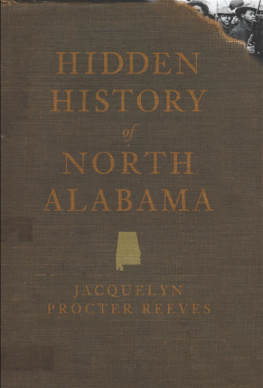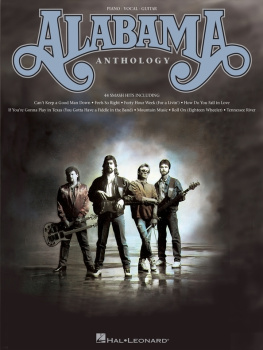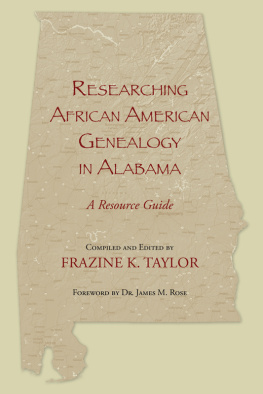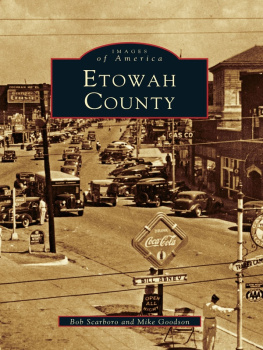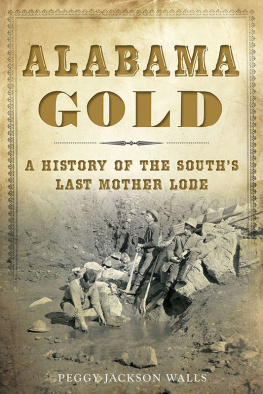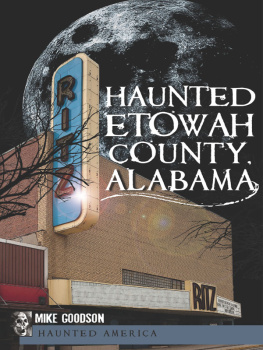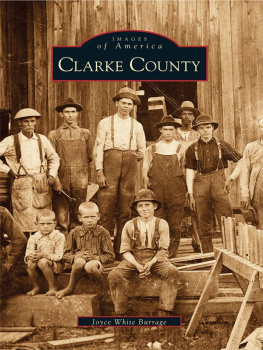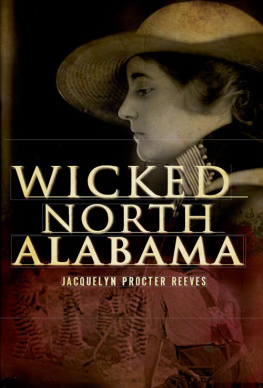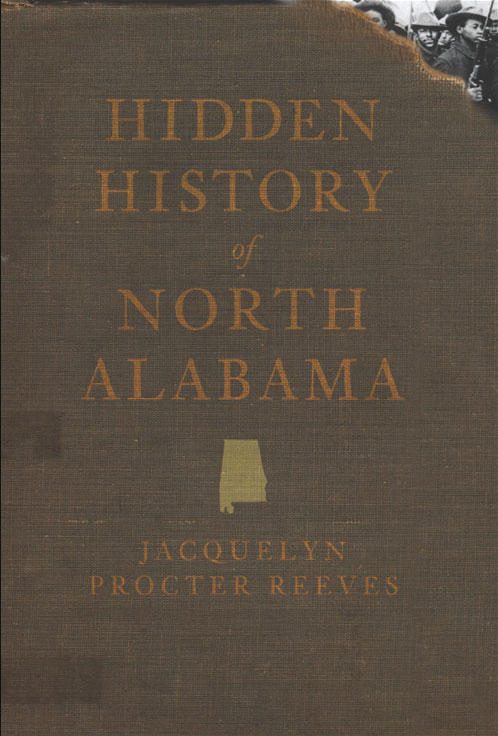HIDDEN
HISTORY
of
NORTH
ALABAMA
HIDDEN
HISTORY
of
NORTH
ALABAMA
JACQUELYN
PROCTER REEVES

Published by The History Press
Charleston, SC 29403
www.historypress.net
Copyright 2010 by Jacquelyn Procter
Reeves All rights reserved
First published 2010
Second printing 2011
e-book edition 2011
ISBN 978.1.61423.221.6
Library of Congress Cataloging-in-Publication Data
Reeves, Jacquelyn Procter.
Hidden history of North Alabama / Jacquelyn Procter Reeves.
p. cm.
print edition ISBN 978-1-59629-752-4
1. Alabama--History, Local--Anecdotes. 2. Alabama--Biography--Anecdotes. I. Title.
F326.6.R44 2010
976.1--dc22
2010011265
Notice: The information in this book is true and complete to the best of our knowledge. It is offered without guarantee on the part of the author or The History Press. The author and The History Press disclaim all liability in connection with the use of this book.
All rights reserved. No part of this book may be reproduced or transmitted in any form whatsoever without prior written permission from the publisher except in the case of brief quotations embodied in critical articles and reviews.
To three women who made a difference in my life:
Rane Pruitt, Pat Lewis and Virginia Cook.
Preface
It is difficult to write a book about history that is unbiased. Readers are left to wonder what is true and what isnt and, most likely, make their own judgments in the end. The best way to make a decision is to be informed of all facts and temper them with common sense. In the end, perhaps it doesnt even matter. Some of us study history for entertainment. But we also realize that what we learn in school is rarely the whole story. Schoolbooks tend to hit the highlights, important facts, and quickly move on. A scratch beneath the surface reveals the story behind the story, and those are the facts we are most likely to remember. Those are the stories I share with you.
There are many people who have helped me tremendously. I can always count on the people at the Archives Department at the Huntsville-Madison County Public Library: Rane Pruitt, Thomas Hutchens and Susanna Leberman. The service they provide to patrons of the library cannot be measured, and their willingness to share their extensive knowledge with anyone and everyone is much appreciated.
I would also like to thank Patrick Hood for allowing me to use his fabulous photograph of the Forks of Cypress. His other pictures, masterpieces all, are on his website: www.patrickhoodphotographer.com.
I am also forever indebted to Chuck and Jo Shaffer, owners of Old Tennessee Valley Magazine, whose generosity is beyond measure. I would also like to thank Robert Gamble, senior architectural historian with the Alabama Historical Commission, for his help and expertise. His knowledge never ceases to amaze me! My thanks to friends Jim and Linda Maples, who support all my endeavors, sound and otherwise, and also to my husband, Robert, who plays devils advocate in order to make me try harder.
Thanks, too, to the many people at The History Press who have become friends in the process of giving birth to a new book. Im glad we met!
Finally, I would like to thank the ladies of the Mooresville Brick Church Choir for much-needed comic relief!
SCItanic
On the morning of Saturday, July 7, 1984, the heat from the Alabama sun was already oppressive as it made its way up into the sky. The morning dew turned to a blanket of steam, drawing the very breath from ones lungs. It seemed to be a perfect day to head to the Tennessee River for a boat ride, catch a cooling breeze and enjoy the company of friends and co-workers. That was exactly what second-shift employees of the South Parkway branch of SCI, an electronics manufacturing company in Huntsville, planned to do that day.
Employees of the Products Division Plant #2 and their families were invited for a leisurely excursion on the company boat, a one-hundred-foot paddle-wheeler given the tongue-in-cheek name SCItanic in a contest held to name the boatan eerie referral to the passenger ship that had perished in the icy Atlantic waters earlier in the century. Another SCI department was originally assigned use of the SCItanic on that day but had traded with members of the Products Division, whose workers had more kids and were eager to take the ride in the daytime as opposed to the more romantic evening cruise scheduled for that night. Although eighty-two people were expected that day, only fifteen showed up, plus a crew of three, including the captain, Frank May, who had a commercial ship pilots license. They would leave from Ditto Landing.
Ditto Landing took the name from a white settler from North Carolina, John Ditto, who arrived in the early 1800s and operated a ferry across the Tennessee River, a 652-mile-long tributary of the Ohio River. John Ditto played an active role in the American Revolution; however, he supported the British. As a result, he left his home state after a number of disputes with his neighbors ended in lawsuits. He came into the territory that would later become Alabama and coexisted peacefully with local Chickasaw Indians as he established his trading post and ferry business.
The Tennessee River, once known as the Cherokee River, dips deeply into northern Alabama, providing fertile soil for the many cotton farmers and recreational opportunities for boaters and fishermen. Hobbs Island skirts the outermost edge of the river near Ditto Landing. The riverbank at Ditto Landing was, and is, a scenic location for picnics, cookouts and camping. The sparkling waters of the river, framed by hardwoods and evergreens against a backdrop of the Appalachian foothills, promised to provide, on July 7, 1984, a pleasant setting for a cruise.
Captain May checked the weather forecast early that morning and confirmed what he thought would be a good day for an outing on the six-year-old boat, originally named Dixie Darling. At 5:30 a.m., the forecast predicted a 30 percent chance of thunderstorms with northerly winds at ten miles per hour and a high of ninety degrees. By 9:30 a.m., when the passengers were beginning to assemble at Ditto Landing to board the SCItanic, the forecast had changed slightly. The radar indicated a band of storms moving from the southeast into North Alabama.
All was well. Guests eagerly anticipated the trip, and there were smiles all around when the boat was launched at about 10:20 a.m. Soon, clouds began to gather in the sky. Captain May spotted a lightning strike in the distance. It was just after 11:00 a.m., and the captain turned up the volume on the NOAA weather radio in time to hear that there was a severe thunderstorm warning issued for Madison and Morgan Counties. May turned the boat around and announced that they would be returning to Ditto Landing. Suddenly the rains came, carried by seventy-mile-per-hour winds, and began to fall in torrents. The passengers rushed into the cover of the salon as the visibility through the curtain of rain dropped from seven miles down to three miles. Only three minutes had passed since the warning on the weather station.
Crew member Marliana Cressey asked if any of the passengers wanted a life preserver; some said they did and quickly strapped them on. The sky darkened ominously, and within only a few minutes, the visibility dropped again to three-quarters of a mile. Still, the captain and crew remained calm. The boat was made to withstand one-hundred-mile-per-hour winds and had made excursions nearly every day since it was purchased by SCI eighteen months earlier.

